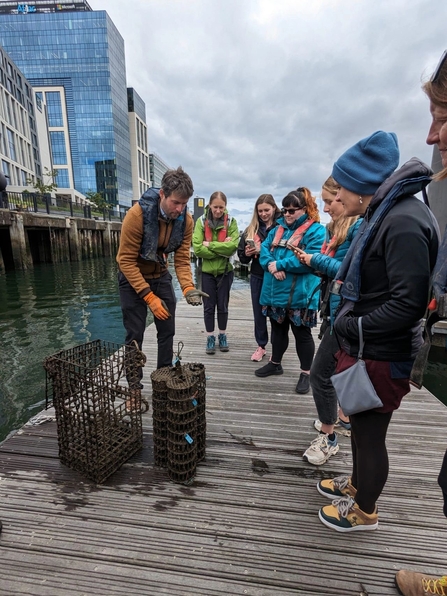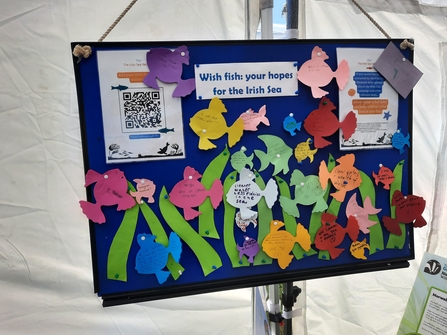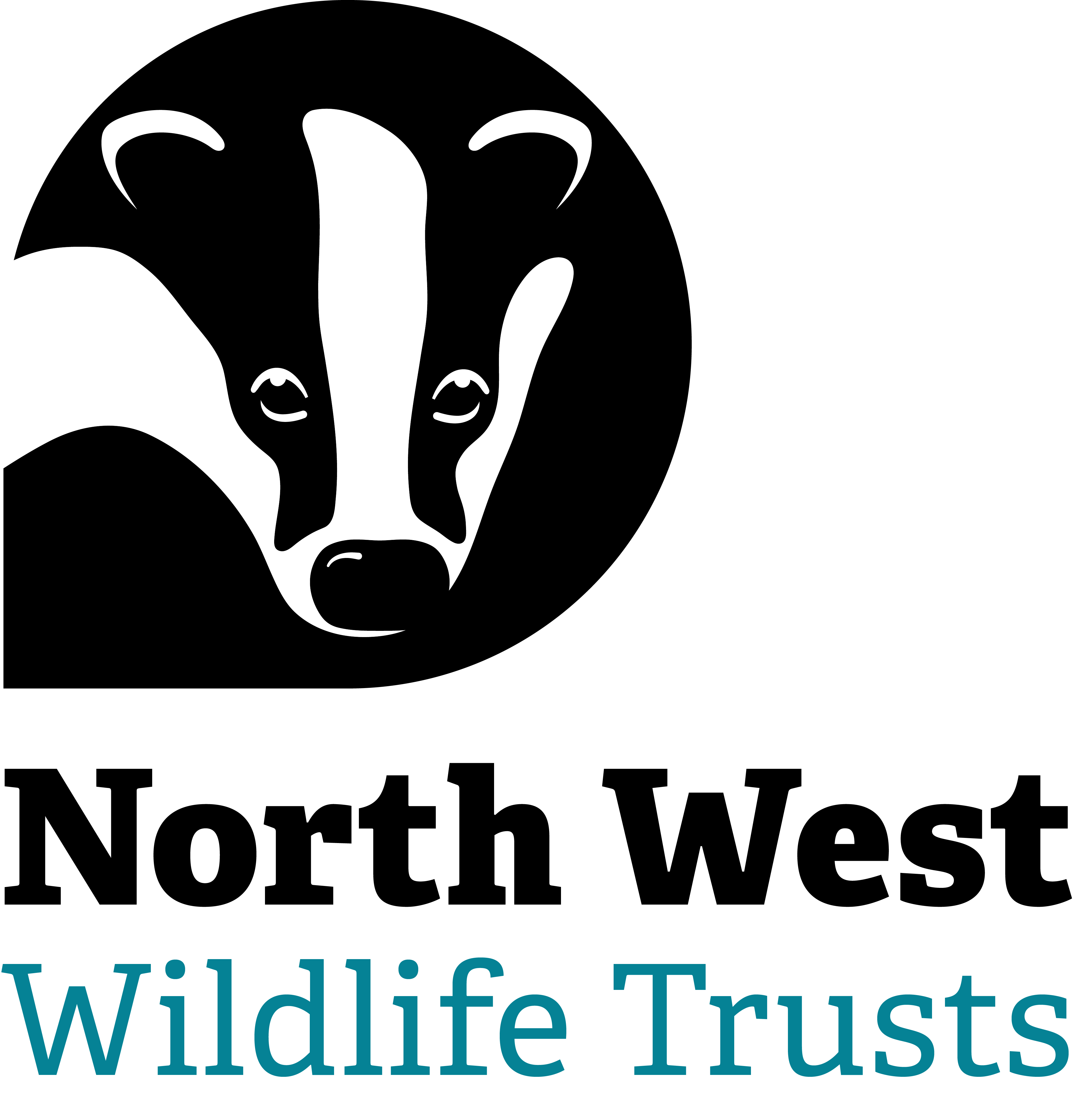Mathieu Lundy, from Ulster Wildlife Trust is showing us their native oyster nursery. Attached to the pontoon, cages provide a secure home for growing oysters. In centuries past, native oysters used to be found all around the British Isles, a plentiful cheap food source. Now, due to overfishing and disease, they are a rare sight.[1] Mathieu handles an oyster carefully with gloves, showing us how this little one has made its home in the abandoned shell of another. Sometimes, he says, public visitors to the nursery don’t even recognise them as living creatures.
Can nature recover in the busy Irish Sea?
Irish Sea Network in Belfast

Oyster restoration in Belfast harbour / credit: Charlotte Ravenscroft
It's a theme that we keep coming back to during meetings of the Irish Sea Network (ISN), a group of Wildlife Trusts and conservation partners around the Irish Sea: how to enlist more public support for marine conservation and restoration efforts. Seeing is believing, but not many people get chance to see what’s happening under the sea.
Over recent years, there has been public outcry about the state of English rivers and beaches, because people can see raw sewage being pumped into them by the water companies. It is visible and visceral. Whereas the immense damage being done to the seabed and marine wildlife, particularly by industrial scale trawling and dredging of the seabed by fishing boats, hasn’t been so obvious from the shore.
Moreover, appeals to the public and policymakers based on the plight of the oyster won’t work if they don’t even realise it’s a living creature. Similarly, at a recent meeting, I gently remind passionate ISN members that the vital role of mud in the marine ecosystem – and therefore the case for protecting it - isn’t always intuitively obvious to people like me, who grew up far from the sea.
Why does public awareness matter? After all, major policy progress has been made in recent years. Most notably, the international commitment to protect 30% of each nation’s waters by 2030 (“30 by 30”). And more locally, with political promises from the Welsh Government and incoming UK Labour MPs to ban bottom trawling in marine protected areas. There is cause for hope. The problem is, for any of this to become a reality, greater public awareness and support is needed.
In the first instance, it is easy for politicians to make promises, it is another to commit the resources to delivering them. Public pressure – like there has been on rivers – would greatly help. The UK Labour MP’s recent commitment was made in the context of a public hustings; we need to keep this pressure up. Because otherwise, marine protected areas can be designated on paper but make no difference in reality – a phenomenon known as ‘paper parks’. The Irish Sea is an example of this: a very busy sea, of which 36% is in theory protected, but in practice only 5% has any management measures in place.
Secondly, limits on trawling and other destructive activities will only work if people follow them. This entails a significant amount of engagement with industry and coastal communities to reach local agreements about what can happen where. While there is strong evidence for protected areas, this sometimes involves a period of piloting a temporary arrangement so that people can see the initial results for themselves – whether fish stocks can recover, whether local fishers can make a good living using more sustainable methods or take on new roles such as monitoring. Longer term agreements can then be forged with greater confidence and support.
Moreover, active restoration efforts of the kind Mathieu is doing with the oysters go a step further. They seek not just to limit damaging activities, but to reintroduce species that have been lost. Like seagrass meadows being re-planted off the coasts of Wales and the Isle of Man, which are known to support biodiversity and help sequester carbon. Reintroducing species can be controversial if the public are unfamiliar with them. Fortunately, both oysters and seagrass thrived in these areas relatively recently and, although few, there are still remnants around the coast from which transplants can be taken. Nonetheless, volunteers, access to suitable re-introduction sites, and limiting disturbances are crucial, so public engagement remains important.
All of this brings us back to the question of whether nature can recover in the Irish Sea? For the Irish Sea Network, the answer is emphatically yes. Yes, but, or yes, and… to make this a reality at scale will take investment, time and public support.
For our part, the last three years have been focussed on generating the shared evidence base and recommendations for change. Going forward, greater public engagement is going to be at the core of ISN’s work. Ideally, by giving people more opportunities to experience, enjoy and get involved in nature recovery efforts. There is something restorative for us all in this. Seeing a busy little world of creatures in a rockpool. Watching wading birds on an unhurried afternoon.
At the end of July, we launched Irish Sea Day with events at 11 sites around the Irish Sea, for the public to enjoy a day out at the beach with wildlife and nature activities. At the event I was at in Anglesey, hundreds of people stopped by and had chance to handle and learn about different marine creatures. At all of the events, the public were asked what they want for the Irish Sea’s future – and to add their ‘wish fish’ to our campaign board. Please do add yours digitally!
The Wildlife Trusts of course do lots of public engagement activities like this already, and they tend to be very popular. But, as the policy sands have shifted, ISN hopes there is a chance to join up the efforts of all its members around the Irish Sea to create a bigger ambition for nature’s recovery and a new story for the Irish Sea. A story about what we love about it and how we can yet recover something that is at risk of being lost.

Wish Fish for Irish Sea Day in North Wales
Charlotte has been the facilitator of the Irish Sea Network (ISN) since it’s inception in 2020. ISN is a collaboration of marine experts from Wildlife Trusts around the Irish Sea, along with representatives from Sustainable Water Action Network and the Northern Irish Marine Task Force.
[1] Clover, C. (2022) Rewilding the Sea

